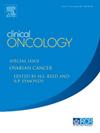The Use of Radiotherapy in the Cure of Different Cancers - Further Results From the FORTY (Favourable Outcomes From RadioTherapY) Project
IF 3
3区 医学
Q2 ONCOLOGY
引用次数: 0
Abstract
Aims
Overall, almost 40% of patients surviving 5 years are estimated to have received radiotherapy (RT). The utilisation of RT for individual tumour types in 5-year survivors was examined.
Materials and methods
Patient-level data on RT utilisation in cancer patients in England were analysed. Patient, tumour, and treatment event data were obtained for the 5-year period 2009–2013, together with 5-year individual patient survival (to 2018 ie pre Covid-19 pandemic). All tumour sites (excluding C44) and ages were included. 5-year survivors (n = 537,970) were divided into 22 tumour sites, plus a category of ‘Other’ (5% of patients) where tumour site was unknown, leaving 508,753 with known tumour site diagnosis.
Results
Overall cancer-specific 5-year survival was 52%. Of the 5-year survivors with definite tumour site diagnosis, 200,269 (39%) received RT. Breast cancer accounted for 50% of RT patients, prostate 24%. 75% of breast cancer 5-year survivors received RT, 65% of head and neck patients, 49% of rectum, 49% of central nervous system (CNS), and 43% of prostate patients. 25% of lymphoma 5-year survivors received RT. Only 29% of lung cancer 5-year survivors received RT. In 6 tumour sites (pancreas, leukaemia, kidney, colon, ovary, and melanoma), <5% of patients (n = 3981, 2%) received RT. Excluding these, 50% of 5-year survivors received RT.
Conclusions
RT contributes significantly to 5-year survival. RT was delivered to 50% of 5-year survivors in tumour sites where RT is utilised for ≥5% of patients. Including the additional tumour sites where RT is used rarely, RT was delivered to almost 40% of patients. We recommend that this exercise is repeated regularly. This 50% figure emphasises the importance of RT. It is critical for service planning and public health messaging. It should be noted for the development of the new cancer plan.
放射治疗在治疗不同癌症中的应用——来自四十(放射治疗的有利结果)项目的进一步结果
总体而言,估计近40%存活5年的患者接受了放疗(RT)。研究了5年幸存者中个体肿瘤类型的放疗使用情况。材料和方法对英国癌症患者放疗利用的患者水平数据进行分析。获得了2009-2013年5年期间的患者、肿瘤和治疗事件数据,以及5年个体患者生存率(至2018年,即Covid-19大流行前)。包括所有肿瘤部位(C44除外)和年龄。5年幸存者(n = 537,970)分为22个肿瘤部位,加上肿瘤部位未知的“其他”类别(5%的患者),留下508,753个已知肿瘤部位的诊断。结果总体肿瘤特异性5年生存率为52%。在确诊肿瘤部位的5年存活患者中,200,269例(39%)接受了放疗。乳腺癌占50%,前列腺占24%。75%的乳腺癌5年幸存者接受了放疗,头颈部患者为65%,直肠患者为49%,中枢神经系统(CNS)患者为49%,前列腺患者为43%。在6个肿瘤部位(胰腺、白血病、肾脏、结肠、卵巢、黑色素瘤)中,5%的患者(n = 3981,2 %)接受了rt。除此之外,50%的5年幸存者接受了rt。结论srt对5年生存率有显著影响。肿瘤部位50%的5年幸存者接受了放疗,其中放疗用于≥5%的患者。包括很少使用放疗的其他肿瘤部位,几乎40%的患者接受了放疗。我们建议定期重复这个练习。这50%的数字强调了rt的重要性。它对服务规划和公共卫生信息传递至关重要。新癌症计划的制定值得注意。
本文章由计算机程序翻译,如有差异,请以英文原文为准。
求助全文
约1分钟内获得全文
求助全文
来源期刊

Clinical oncology
医学-肿瘤学
CiteScore
5.20
自引率
8.80%
发文量
332
审稿时长
40 days
期刊介绍:
Clinical Oncology is an International cancer journal covering all aspects of the clinical management of cancer patients, reflecting a multidisciplinary approach to therapy. Papers, editorials and reviews are published on all types of malignant disease embracing, pathology, diagnosis and treatment, including radiotherapy, chemotherapy, surgery, combined modality treatment and palliative care. Research and review papers covering epidemiology, radiobiology, radiation physics, tumour biology, and immunology are also published, together with letters to the editor, case reports and book reviews.
 求助内容:
求助内容: 应助结果提醒方式:
应助结果提醒方式:


